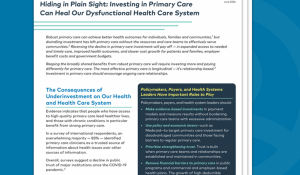You are looking at an archived version of our site. Please visit thepcc.org for a fresh, new experience!
You are here: Array » Enhanced Personal Heal ...
Enhanced Personal Health Care Program - Ohio
Program Location:
Columbus, OH
Payer Type:
Commercial
Parent Program:
Payers:
Anthem Blue Cross
Reported Outcomes
Description:
The Enhanced Personal Health Care Program empowers primary care physicians (PCPs) to engage in comprehensive primary care functions that move toward a coordinated, evidence-based care model that has the greatest impact on achieving the triple aim of improved quality, patient experience and affordability.
This Program:
- Makes a significant investment in primary care that allows primary care physicians and their practice team to do what they can do best: manage all aspects of their patients’ care.
- Provides primary care physicians with tools, resources and meaningful information that promotes (1) access, (2) shared decision making, (3) proactive health management, (4) coordinated care delivery, (5) adherence to evidence based guidelines and (6) care planning built around the needs of the individual patient, leading to improved quality and affordability for customers and their patients.
- Helps redesign the current payment model to move from volume based to value based payment, aligning financial incentives and providing financial support for activities and resources that focus on care coordination, individual patient care planning, patient outreach and quality improvement.
Improves the patient experience by:
- Creating better access to a primary care physician who will not only care for their “whole person” but will become their health care champion and help them navigate through the complex health care system,
- Making them active participants in their health care through shared decision making, and
- Optimizing their health.
Related News & Resources
March 2015 - Resource
Payment Model:
Primary care physicians who maintain or improve quality will be able to earn revenue in three ways:
- General increase to the regular fees paid to physician practices for specific services,
- Payment for additional services currently not reimbursed, with an initial focus on compensation for preparing care plans for patients with multiple and complex conditions, and
- Shared-saving payments for quality care and reduced medical costs.
Fewer ED / Hospital Visits:
- 7.8% fewer inpatient admissions per 1000
- 5.7% fewer inpatient days per 1000
- 7.4% decrease in acute admissions for high-risk patients with chronic conditions
- 3.5% decrease in ER costs and 1.6% reduction in ER utilization
Cost Savings:
Initial analysis found gross medical savings of $9.51 per attributed member per month (PaMPM) for members who saw EPHC providers compared to those who did not - a 3.3 percent reduction in medical costs.
5.1% PaMPM decrease in outpatient surgery costs*
Increased Preventive Services:
Results showed an increase of 22.9 per 1,000 PCP visits for high-risk patients.*
Other Outcomes:
*Based on overall program analysis, not Ohio-specific
Last updated March 2019
Secondary menu
Copyright © 2024 Primary Care Collaborative









